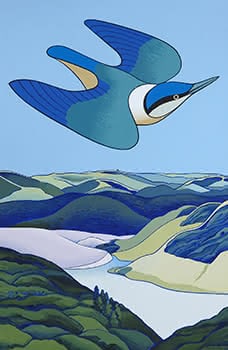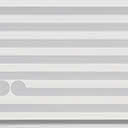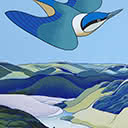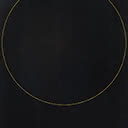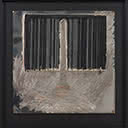Swoop of the Kotare
109 x 71.5 cm
est. $800,000 - 1,200,000
PROVENANCE
Private Collection, Christchurch
Acquired from Gow Langsford Gallery, c.2007
In Maori and Polynesian tradition, the kotare - or sacred kingfisher - is believed to have power over tides and waves. It also has strong associations with watchfulness and guardianship - two qualities which Don Binney, an ardent environmentalist, often found sadly lacking in the human world. There were lessons that could be learnt from these and other bird species - a point he often made - drawing attention to their inbuilt sense of balance, mobility, organisational skills and grace. In a 1972 interview with John Daly-Peoples, he afforded birdlife elder status, asserting that they have lived in harmony and have coexisted with the topography, with the space, with the light, of habitable earth space so much longer than people. With the visual intensity and hyper-clarity of a dream, Swoop of the Kotare is a powerful amalgam of two important subjects from earlier in the artist's career: the bird in flight and Lake Wainamu, a short distance inland from the beach at Te Henga, where he maintained a studio for nearly two decades. The kotare first appeared in Binney's art in 1964. In his early masterpiece, Kotare over Ratana Church, Te Kao, the fluid, almost futuristic form of the bird is elongated and stretched across the width of the painting. Binney described his subject, in this instance, as Tai Tokerau's ubiquitous-flying kotare (Pacific sacred kingfisher, Halcyon sancta) skewering the space above the consecrated shape. But it was the painting from the following year, Kotare Over Hikurangi, that provided the prototype for the bird in the 1983 painting. In Swoop of the Kotare, he relocated the bird to the dune-impounded lake (Binney's description) of Wainamu. The stylised treatment of the bird in flight, the scale and its position in the composition are almost identical to those in the 1965 painting (although the bird has been flipped so that it now flies from left to right). During later phases of his career, Binney often revisited earlier themes and subjects in said fashion, not slavishly copying material but seeking new visual challenges and solutions. An exhibition devoted to this approach, Don Binney: Revisiting, was shown at Brooke-Gifford Gallery in 1999. By way of explanation, he wrote: Artists draw a lot from their own past. I have no inhibitions about reviving my earlier forms and recycling them ... As well as numerous preliminary drawings and variations on the kotare/ Wainamu theme, Binney produced an earlier, almost-exact version of this composition, a serigraph/screenprint titled Swoop of the Kotare, Wainamu, commissioned by art dealer Peter Webb in 1980. The image proved so popular that in 1986 a second edition, with slightly different coloration, was released. It was in 1977 that Don Binney was forced, for personal reasons, to relinquish his leasehold bach at Te Henga. By then, the beach and environs had long been established as both his plein air studio and his adopted turangawaewae. Crestfallen, he moved the contents of his studio into the old Wooden Mansions at Elam School of Fine Arts, where he held a teaching position, and where this work was probably painted. Postdating Binney's departure from the Te Henga studio by six years, the 1983 painting encapsulates what was, in hindsight, an Edenic phase in the artist's life. Iconic and emblematic, yet also deeply personal, the high-flying bird is a messenger or envoy from that earlier time. It is a still, translucent day in Binney's timeless vision of kotare and lake. With its body inclined downwards and its head and beak upraised, the bird sets up an arabesque, swirling movement which continues in the contours of the land. There are no atmospherics or shadows; glare off the lake bathes the dunes and surrounding hills in a sharp yet otherworldly light. This is Binney's peaceable kingdom at its most transfixed and resolved - a place he would continue to paint from memory, photographs and drawings until the end of his life. GREGORY O'BRIEN
Born in Auckland, Don Binney grew up in Awatea Road, Parnell. As the only child of his wool broker father and wife Mary, the relationship between mother and son was close. It is thanks to her that drawings from Binney's childhood and beyond were retained for safekeeping. A youthful fascination with birds and their place in the natural world was further encouraged during Binney's time at Kings College, when he joined with classmates in bird-spotting. The artist's life-long connection with Te Henga/Bethells Beach, is also traced to these early years. On his 11th birthday young Binney begged his parents to take him there for a day out, this lead to the family renting a homestead cabin at the southern end of the beach. This early connection remained a continuous thread throughout the artist's life and work. In 1962 Binney began painting at Te Henga and views of Puketotara with indigenous birds became a key motif in his work. In bird watching Binney said he discovered a passage into the landscape and the opportunity to develop a personal relationship with it. In 1965 Binney was included in a survey show of New Zealand painting held in London and the Eight NZ Artists touring show of Australian state galleries. In 1967 he was the recipient of a Queen Elizabeth II Arts Council travel fellowship which enabled him to live and work in Mexico, London and Australia. Binney returned to teach at the Elam School of Fine Arts as Head of Painting. He was awarded an OBE for services to the arts in the 1995 Queen's Birthday Honours and retired in 1998 after 24 years of teaching. In the following years, Binney continued to focus on his art, travelling extensively throughout New Zealand and to places of international spiritual significance. From 2002 he worked increasingly in charcoal and coloured pencils because of their portability and simply because he loved the intimacy of the medium. Binney exhibited continuously from the 1960s until his death in September 2012, aged 72.
As one of New Zealand's most important twentiethcentury artists, Binney is represented in both private and public collections including the Auckland Art Gallery, The University of Auckland and Museum of New Zealand Te Papa Tongarewa. Don Binney, 1977-79, New Zealand, by Marti Friedlander. Te Papa (O.031286), Courtesy of the Gerrard and Marti Friedlander Charitable Trust

